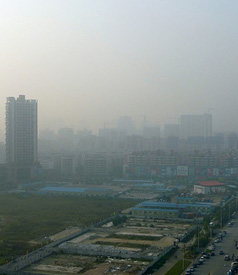At the Copenhagen Climate Summit in December 2009, CO2 was at the center of everyone’s attention. The United States and China, the premier planetary polluters, succeeded in laboriously reaching a minimal agreement on emission reductions for that gas.
Another greenhouse gas, ozone, would undoubtedly have deserved to be invited into the discussions between the two giants. According to a study published by “Nature” on January 21, part of this pollutant originating in Asia is found several days later over the Western United States, enough to imperil American ozone regulations.
We have long known that pollution is a globalized phenomenon: Isn’t human-caused CO2 accused of ruining the planet’s climate? Don’t we find heavy metals and persistent organic pollutants produced in industrialized countries thousands of kilometers away in the bodies of the Arctic Inuit and polar bears? Are not whole regions of the Pacific colonized by an ocean of plastic debris? Ozone is but one striking example of these long-distance pollution exports.
For people, responsible for its fluctuations, this gas is decidedly a puzzler. When there is not enough of it in the upper layers of the atmosphere, it no longer plays its protective role with respect to ultraviolet rays. But when ozone is too concentrated in the troposphere, that is, in that envelope of the first ten kilometers of the atmosphere in which life developed, it behaves like a poison to flora and fauna. Leaves are oxidized by the O3 (3 oxygen atom) molecule, which also attacks the airways of animals and humans.
But if ozone is too scarce at high altitude, and too concentrated close to the ground, it’s people’s fault: refrigerant and propulsive gases are responsible for ozone’s decrease at high altitude. Of course, the Montreal Protocol (1987) allowed the use of those gases to be restricted, but it will still take decades before the famous “holes” in the ozone layers around the poles are reduced.
As for ozone in the troposphere, things have begun badly: that ozone, the concentration of which has more than doubled during the 20th century, is a so-called pollutant, produced by the sun shining on “precursor” pollutants, notably nitrogen dioxide emitted in vehicle exhaust, as well as from chimneys, incinerators and forest fires.
Thus, indirect measures have already shown that deforestation in Indonesia is responsible for an ozone plume that may spread as far as East Africa. These movements take place on different scales: in France, the levels of tropospheric ozone are higher in rural areas because it often takes several days for photochemistry to transform the primary pollutants from industrialized areas into O3.
That’s also the case between Asia and the United States in the spring. Researchers at the American National Oceanic and Atmospheric Administration (NOAA) were able to trace this ozone back to its source through numerous measures, including some conducted by airliners equipped with sensors through an initiative of the aerology laboratory of Toulouse (CNRS). “That [program] provides one of the most obvious proofs of these transports to date,” notes Kathy Law (of the universities Paris-VI and Versailles, CNRS).
It must still be verified that this imported ozone, measured at several kilometers of altitude, truly ends up falling on the ground, where its impact on agriculture, as well as human and animal health, makes itself felt. The issue is important: In Europe, for example, a study by the European Environmental Agency judged that ozone pollution in 2007 was the cause of 21,400 premature deaths per year. On the agricultural side, the studies judged that in 2000, the cost in terms of global yield loss was between $14 billion and $26 billion.
In developed countries, ozone pollution peaks have tended to be less severe in recent years, thanks to the implementation of regulations on precursor pollutants. Chronic pollution has nonetheless increased regularly. During coming decades, the most appreciable rise will involve Africa and Asia.
To the extent that O3, unlike CO2, survives only a few weeks in the atmosphere, “there would be an immediate double benefit to controlling ozone precursors,” Kathy Law asserts: “to fight against its impact, but also against global warming.” One of the protocols of the 1988 convention on long-distance cross-border atmospheric pollution – intended originally to fight against acid rain – aims specifically at reducing nitrogen dioxide. The United States is a signatory. China still has to be convinced to adhere.
Translation: Truthout French Language Editor Leslie Thatcher.
Join us in defending the truth before it’s too late
The future of independent journalism is uncertain, and the consequences of losing it are too grave to ignore. To ensure Truthout remains safe, strong, and free, we need to raise $43,000 in the next 6 days. Every dollar raised goes directly toward the costs of producing news you can trust.
Please give what you can — because by supporting us with a tax-deductible donation, you’re not just preserving a source of news, you’re helping to safeguard what’s left of our democracy.
